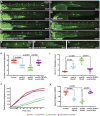Cxcl12a induces snail1b expression to initiate collective migration and sequential Fgf-dependent neuromast formation in the zebrafish posterior lateral line primordium
- PMID: 29945870
- PMCID: PMC6078336
- DOI: 10.1242/dev.162453
Cxcl12a induces snail1b expression to initiate collective migration and sequential Fgf-dependent neuromast formation in the zebrafish posterior lateral line primordium
Abstract
The zebrafish posterior lateral line primordium migrates along a path defined by the chemokine Cxcl12a, periodically depositing neuromasts, to pioneer formation of the zebrafish posterior lateral line system. snail1b, known for its role in promoting cell migration, is expressed in leading cells of the primordium in response to Cxcl12a, whereas its expression in trailing cells is inhibited by Fgf signaling. snail1b knockdown delays initiation of primordium migration. This delay is associated with aberrant expansion of epithelial cell adhesion molecule (epcam) and reduction of cadherin 2 expression in the leading part of the primordium. Co-injection of snail1b morpholino with snail1b mRNA prevents the initial delay in migration and restores normal expression of epcam and cadherin 2 The delay in initiating primordium migration in snail1b morphants is accompanied by a delay in sequential formation of trailing Fgf signaling centers and associated protoneuromasts. This delay is not specifically associated with knockdown of snail1b but also with other manipulations that delay migration of the primordium. These observations reveal an unexpected link between the initiation of collective migration and sequential formation of protoneuromasts in the primordium.
Keywords: Cell adhesion molecule; Collective migration; Cxcl12a; Lateral line primordium; Snail1b; Zebrafish.
© 2018. Published by The Company of Biologists Ltd.
Conflict of interest statement
Competing interestsThe authors declare no competing or financial interests.
Figures







Similar articles
-
Leading and trailing cells cooperate in collective migration of the zebrafish posterior lateral line primordium.Development. 2014 Aug;141(16):3188-96. doi: 10.1242/dev.106690. Epub 2014 Jul 25. Development. 2014. PMID: 25063456 Free PMC article.
-
Modeling factors that regulate cell cooperativity in the zebrafish posterior lateral line primordium.J Theor Biol. 2018 May 7;444:93-99. doi: 10.1016/j.jtbi.2018.02.009. Epub 2018 Feb 20. J Theor Biol. 2018. PMID: 29470991
-
HDAC3 Is Required for Posterior Lateral Line Development in Zebrafish.Mol Neurobiol. 2016 Oct;53(8):5103-17. doi: 10.1007/s12035-015-9433-6. Epub 2015 Sep 22. Mol Neurobiol. 2016. PMID: 26395281
-
A framework for understanding morphogenesis and migration of the zebrafish posterior Lateral Line primordium.Mech Dev. 2017 Dec;148:69-78. doi: 10.1016/j.mod.2017.04.005. Epub 2017 Apr 28. Mech Dev. 2017. PMID: 28460893 Free PMC article. Review.
-
NetLogo agent-based models as tools for understanding the self-organization of cell fate, morphogenesis and collective migration of the zebrafish posterior Lateral Line primordium.Semin Cell Dev Biol. 2020 Apr;100:186-198. doi: 10.1016/j.semcdb.2019.12.015. Epub 2019 Dec 31. Semin Cell Dev Biol. 2020. PMID: 31901312 Review.
Cited by
-
The extracellular matrix in development.Development. 2020 May 28;147(10):dev175596. doi: 10.1242/dev.175596. Development. 2020. PMID: 32467294 Free PMC article. Review.
-
Tmem88 plays an essential role in pharyngeal pouch progenitor specification by inhibiting Wnt/β-catenin signaling.Life Med. 2023 Nov 17;2(6):lnad044. doi: 10.1093/lifemedi/lnad044. eCollection 2023 Dec. Life Med. 2023. PMID: 39872065 Free PMC article.
-
GPI transamidase complex is required for primordial germ cell migration and development in zebrafish.J Mol Cell Biol. 2025 Jun 12;16(12):mjae058. doi: 10.1093/jmcb/mjae058. J Mol Cell Biol. 2025. PMID: 39741393 Free PMC article.
-
EpCAM regulates hair cell development and regeneration in the zebrafish lateral line.MicroPubl Biol. 2024 May 8;2024:10.17912/micropub.biology.001219. doi: 10.17912/micropub.biology.001219. eCollection 2024. MicroPubl Biol. 2024. PMID: 38800699 Free PMC article.
-
Trap-TRAP, a Versatile Tool for Tissue-Specific Translatomics in Zebrafish.Front Cell Dev Biol. 2022 Jan 31;9:817191. doi: 10.3389/fcell.2021.817191. eCollection 2021. Front Cell Dev Biol. 2022. PMID: 35174174 Free PMC article.
References
-
- Balabanian K., Lagane B., Infantino S., Chow K. Y. C., Harriague J., Moepps B., Arenzana-Seisdedos F., Thelen M. and Bachelerie F. (2005). The chemokine SDF-1/CXCL12 binds to and signals through the orphan receptor RDC1 in T lymphocytes. J. Biol. Chem. 280, 35760-35766. 10.1074/jbc.M508234200 - DOI - PubMed
Publication types
MeSH terms
Substances
Grants and funding
LinkOut - more resources
Full Text Sources
Other Literature Sources
Molecular Biology Databases
Research Materials
Miscellaneous

